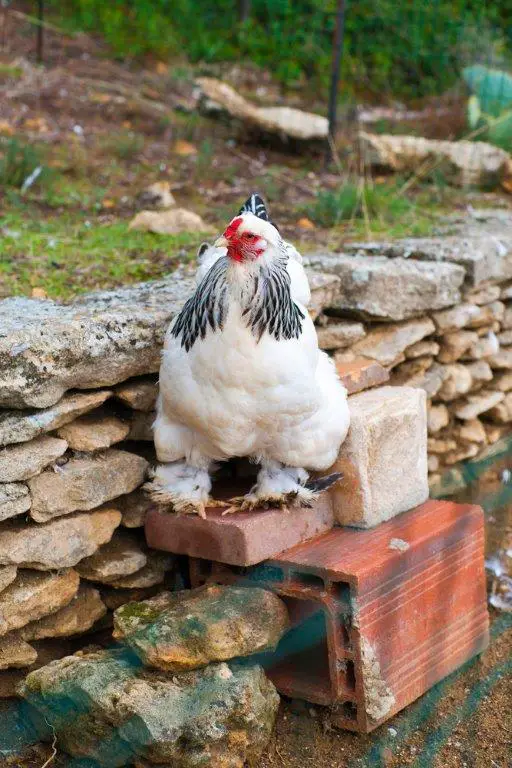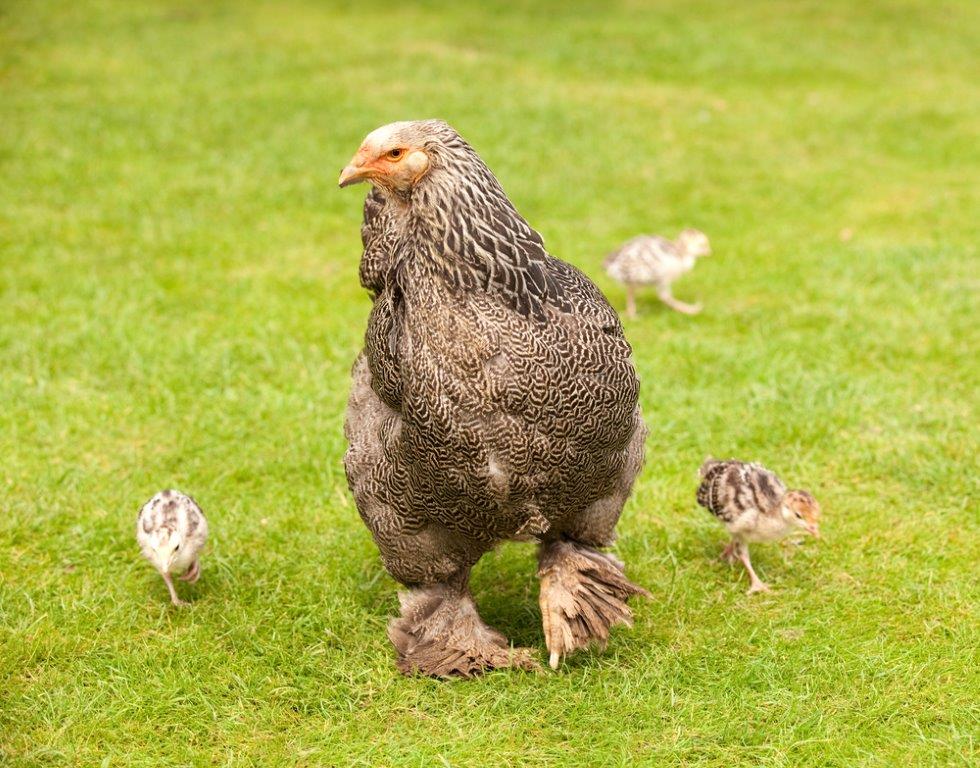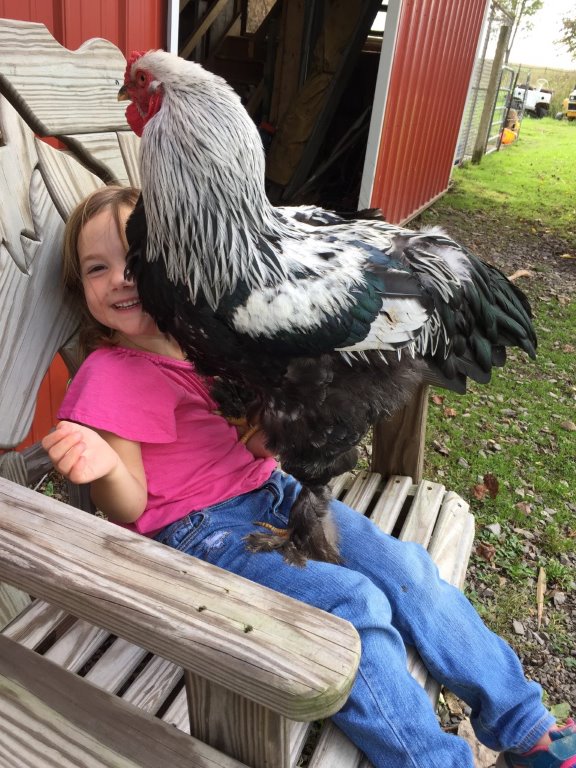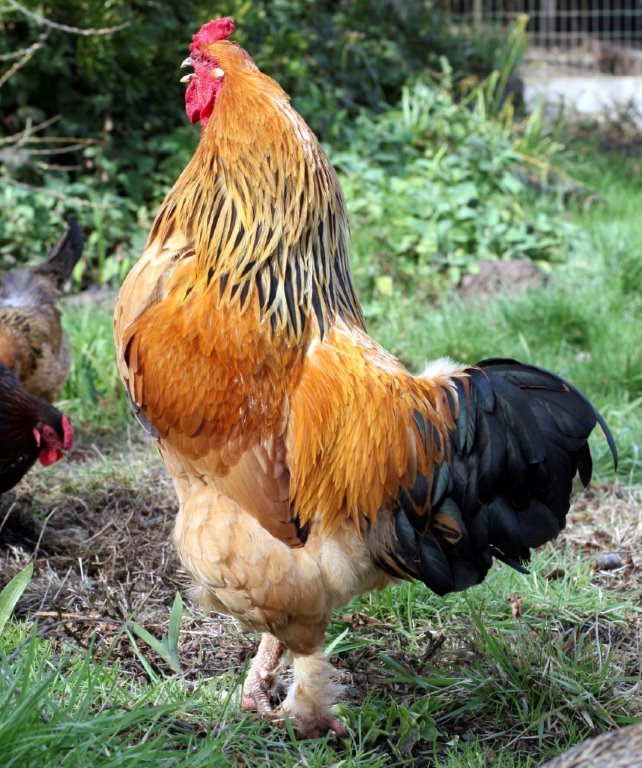Brahma Chicken – The Gentle Giant’s Coop Requirements

Brahma Chicken Quick Facts
- Known for: the gentle giant, dual-purpose meat/egg layer, and good for families and beginners
- Temperament: friendly, docile, handles confinement well
- Eggs: 150 large light brown eggs each year
- Meat: excellent—reaches maturity at 20 weeks with 12 lb males and 9.5 lb females
- Climate: good heat tolerance and excellent cold tolerance, will continue laying through winter
- Broodiness: Brahmas are very likely to go broody and sit on their eggs
Brahma Chicken Overview
The Brahma chicken was the most widely farmed chicken in America at the beginning of the 20th century because it is an exceptionally large meat bird and lays a moderate amount of eggs even through the winter. Brahma chickens handle confinement well and are very docile and friendly.
Brahma chickens will lay 150 large brown eggs each year. Brahma chickens truly shine as meat birds. Because Brahma chickens are so large, they can be heavy eaters and a little cranky when they miss a meal. They will also need a little extra space in the coop and run because of their huge size.
If you live in a very hot climate, Brahma chickens might not be right for you as they are so large with lots of feathers they can overheat easily. Brahmas are very quiet, so if you live in a neighbor they could be perfect for you, providing they have enough space.
Pros and Cons of Brahma Chickens
- Pros: One of the largest meat birds, handles confinement well, is very gentle and sweet, quiet, do very well in cold climates, and many lay through the winter
- Cons: Eat a lot, can overheat in hot weather, egg production is moderate
Brahma Chicken Appearance
- Size: Extra large-sized birds 9.5 lb females and 12 lb males
- Color: Buff, dark, and light
- Egg Color: Brahma chicken eggs are brown in color
The Brahma chicken is a rather intimidating-sized bird, especially for small children. Though it is a large bird, it has very full feathers which make it appear even bigger. Its feathers extended over its feet and it has beautiful tightly woven feathers which keep it dry.
Brahma chickens can be more difficult to sex, though you may notice more curious personalities and larger comb and waddles in the cockerels, and quicker feathering in the pullets. To be sure of their sex, you’ll need to wait nearly five months since they are a more slowly developing breed.

Brahma Chicken Egg Production
Brahma chickens are not prolific egg layers and will lay a moderate amount of eggs—about 150 eggs per year. The broody nature of Brahma chickens does lower their egg production. So if you’d like to get more eggs from your Brahma, collect eggs daily to keep them from setting on a full clutch.
Their brown eggs size ranges from medium to large, which is not that impressive for such a large bird. Hens will reach full maturity at 20 weeks, and they should start laying shortly after, though it can take up to seven months for some Brahma hens to start laying. To keep your birds healthy and productive, keep their coop and run clean. You can also give them a separate bowl of oyster shells or crushed eggshells to consume as desired. These supplements will provide the extra calcium they require to lay eggs as well as possible.
Brahma Chicken Meat Production
The Brahma is excellent meat-producing chicken and was used almost exclusively for chicken meat in America from 1840 through 1930. The Brahma was known as The King of Chickens. Though they are slower growing, their size makes up for it.
You can process Brahma chickens as early as 8 to 10 weeks and they will often big as bigs as a 6-month-old chicken of a standard breed. You can also let them continue growing to get the most meat possible and butcher at 7 to 8 months old. If you are using Brahma’s for meat chickens, do keep in mind they eat quite a lot of feed and factor that into your cost and the timing of harvesting your chickens.
Brahma Chicken Broodiness
A Brahma hen may take a very long while to go broody and set on a clutch of eggs. But once they do go broody, they are extremely determined mothers and excellent brooders. If you want to hatch fertilized Brahma chicken eggs yourself, you can purchase an incubator that automatically turns your eggs, and controls the temperature and some models even control the humidity.
Because Brahma chickens are so large and heavy, it’s a good idea to check on her chicks once they hatch and be sure she’s not accidentally crushing them. To help her along, give her a separate brooding space from the rest of the flock that has ample space for her and her chicks to move around.

Brahma Chicken Temperament
Brahma chickens are calm, docile, and easy to handle. They are friendly and will follow you around and softly talk to you. Because of their size, they aren’t really able to fly and mostly stay close to the ground. This helps them tolerate confinement well, though they do like to forage.
Even though Brahmas are so friendly and sweet, they’re not the kind of chicken you can easily pick up and hold or place in your lap, though some owners still do.
Their size also puts them at the top of the pecking order, so other breeds of chicken usually give them their space and don’t bother them. However, more aggressive breeds may bully Brahmas because they are so docile and don’t fight back. This temperament makes them great flock leaders and protectors.
Even though they are known for their calm personalities, they can also be a little goofy and fun to watch. They are wonderful with children and love to be petted. Brahma chickens would be an excellent choice for new chicken owners and families.

Brahma Chicken Noise Level
Even with their large size, Brahma chickens are very quiet and calm. This would make them a good choice for a neighborhood as long as they have enough space. When they do make sounds, it’s a gentle egg song or a predator alert.
Brahma Chicken Care
Thankfully the Brahmas are hardy and healthy chickens with relatively few health problems requiring extra care. When they do need special care, it is often due to their feathered feet and large number of feathers.
You will want to keep the coop and run clean and free of manure build-up and soiled bedding. Because of their feathered feet, Brahma chickens can pick up and carry more dirt and potentially bacteria, so make cleaning a regular priority. You can also get your chicks vaccinated or use medicated chick starter, and put a few teaspoons of apple cider vinegar in their plastic waterer to boost their immune systems.
If your Brahma’s feet do become caked with mud and manure, they can freeze into balls in the wintertime and lead to frostbite and lost toes. If you do notice these frozen balls of mud develop in their feet, the easiest way to remove them is simply to wash them off.
If you live in a warm climate, you will have to take extra care your Brahma chicken doesn’t overheat with its large size and abundant feathers. Make sure they have areas of shade, the coop has plenty of ventilation, and you can even provide a kiddie pool of water they can walk in to cool off.
To learn more about how to take care of your Brahma chickens, read our Ultimate Guide to Taking Care of Chickens.
Brahma Chicken Housing
Brahma chickens will require extra space in the coop, run, and nesting boxes because of their large size. They need six square feet each inside their coop, and fifteen square feet each in their run.
Even though Brahma chickens are so heavy they can’t fly well, they still love to roost. Make sure to provide a low roosting space in the coop with ten inches of roosting space per chicken. Your hens will need about one nesting box for every three hens so they don’t get too crowded and a good size for a Brahma nesting box is 14×14 inches. Both the perches and nesting boxes should be low to the ground since your Brahma chickens can’t quite fly.
If you are using an enclosed run, sand is best so the Brahma’s feathery feet don’t get muddy and caked. Brahmas do love to free-range, and because of their large size are not typically taken by hawks.
Feeding Brahma Chickens
Brahma chickens can be given standard chick starter from hatching till they reach maturity around 20 weeks. Even though Brahma’s may be slower to lay, you can begin to give them standard layer feed at 20 weeks. Layer feed contains 16% protein and added calcium to keep their eggshells healthy and strong. Roosters can eat the same feed as the hens.
You will notice that Brahma chickens eat a lot of food due to their big size. We don’t recommend you ration their food, which can make them cranky and bossy to other flock members. It’s best to leave their feed available at all times so they can freely choose how much to eat.
You may give your Brahma chickens as much free-roaming space to eat plants and bugs as you can provide. They’ll also enjoy kitchen scraps (though there are some that are harmful, so avoid avocados, dried beans, junk or rotten food, green potato skins, citrus, onions, or tomato or potato leaves from the garden.) Giving them this variety will not only help you save money on their large feed requirements but will also keep them healthy and entertained.
Offering Brahma chickens grit is important for their health. Since chickens don’t have teeth, they need fine gravel or coarse sand in their gizzards to digest their food. Free-range chickens can usually naturally find this, but if your Brahma chickens don’t have access to pebbles, sand, or fine gravel, you’ll want to offer some supplemental grit.
Chicken scratch is also an important supplement to offer to Brahma chickens who are confined to a run or small space. Scratch is a mixture of whole grains that stimulates pecking and scratching behaviors which are soothing to chickens.
Chicken Treats: You don’t HAVE to give your Brahma chickens treats, but it’s a lot of fun! Mealworm and black soldier fly larva treats are excellent snacks for chickens that you can get from the feed store. Brahma’s are so enthusiastic about chicken treats you can even teach them to do simple tricks for them.

What is it like to own a Brahma Chicken?
Brahma chickens are adored by their owners because of their friendly, calm, sweet personalities. They also do wonderfully in the cold weather and make excellent mothers once they decide to brood. They are protective and attentive to their young, and the roosters are very loving and protective of the hens.
Brahmas make excellent pets and are great for kids because they are so fluffy and love to be petted. They love to eat which makes them very motivated by treats. You can teach them to do simple tricks for their treats like coming when called and jumping over things.
Brahmas are curious and bright-eyed, and often the first breed in the flock to inspect something new. Even though they are extremely large, if you sit down on their level they will often jump in your lap and go to sleep.
Brahma Chicken Breed History
The Brahma chicken origins are uncertain, though they are likely descended from Shanghai chicken from China and Chittagongs from Bangladesh.
They were brought to the US around the 1840s and given the name Brahmaputra which is now shortened to Brahma. Because of their huge size and gentle personality, they were the primary source of chicken meat in America for nearly 100 years.
Summary
For many small poultry farmers, the Brahma chicken becomes the most adored in the flock because of its sweet, calm demeanor. They are wonderful for new chicken farmers and families with children. These gentle giants do exceptionally well in the cold weather and many will lay eggs through the winter months.
Brahma chickens make excellent mothers when they go broody and lay a moderate amount of eggs each year—around 150. Their exceptional size makes them excellent meat chickens as well.
Do you own Brahma chickens? Let us know in the comments below what your experience has been.

Leave a Reply